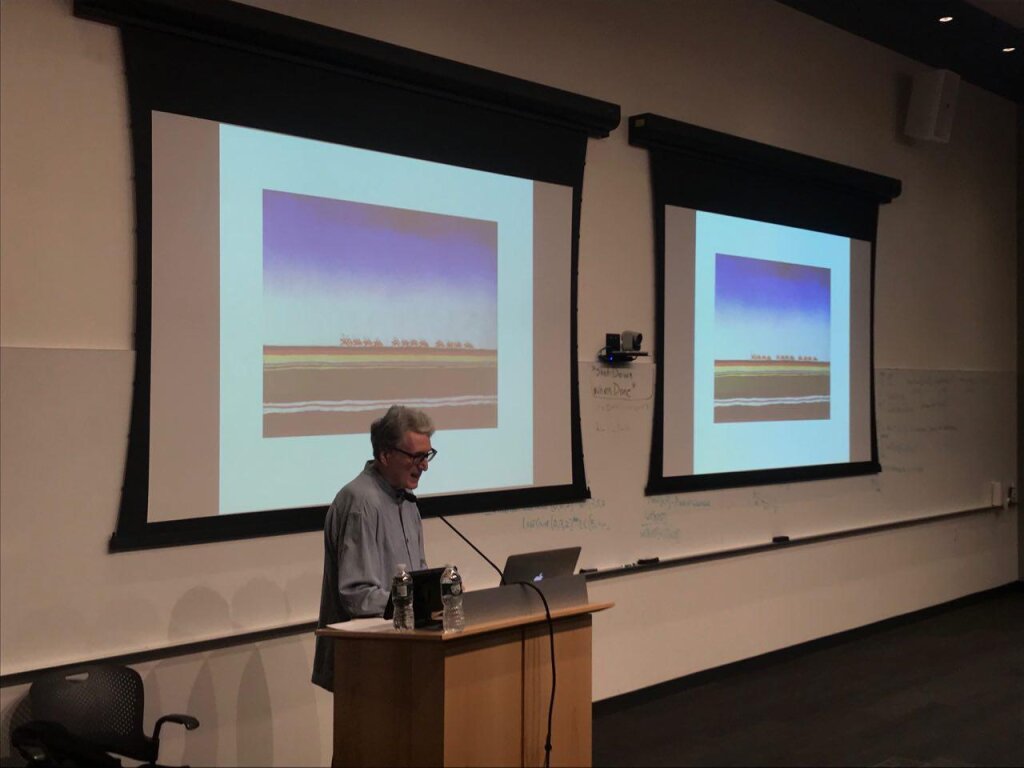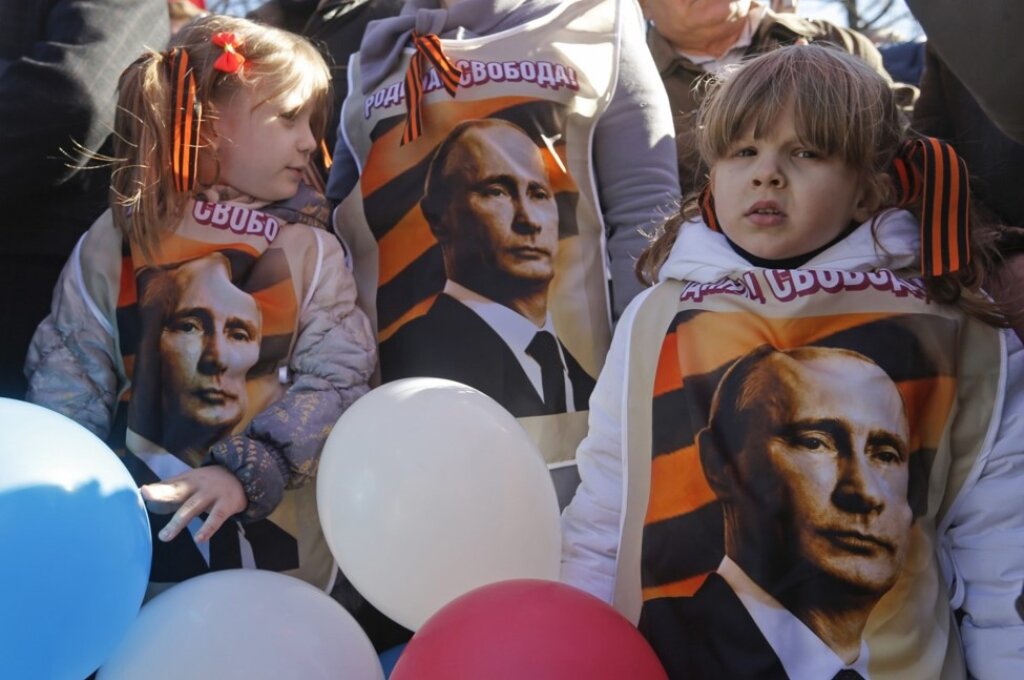On Thursday, Oct. 10, more than 80 students, professors, curators, and artists gathered to see NYU’s Boris Groys for his talk, “The Cold War Between the Medium and the Message: Western Abstract Art vs. Socialist Realism.” Boris Groys, Global Distinguished Professor of Russian and Slavic Studies at NYU, is a philosopher, essayist, art critic, media theorist, and world-renowned expert on Soviet-era art and literature. The talk was introduced by Joshua Tucker, Director of the Jordan Center, as part of the Jordan Center Distinguished Lecture series.
The talk revolved around the tension between socialist realism and Western modernism before and during the Cold War. The conflict between the two artistic vectors was, according to Groys, first articulated by Clement Greenberg in his 1939 essay “Avant-Garde and Kitsch,” which fashions the avant-garde as the continuation of the European tradition, painting it as high art. Kitsch, on the other hand, is presented as a primitive form of “low art” in the essay. In a later essay, Greenberg likened Socialist Realism to kitsch, “a low, bad form of art, mere visual propaganda – comparable to the Western commercial advertisement.” Such a characterization, explained Groys, has prompted the Western world to neglect the socialist realist genre as lowbrow and not worthy of being preserved in a museum, reinforcing Cold War dichotomies of “good” and “bad.” The “medium” of socialist realism is seen as nothing more than an instrument for its “message,” propaganda.
Since the start of the 20th century, however, the Russian and European avant-garde artists, who the art world now holds in high esteem, used their artistic mediums to promote agendas. The Russian Constructivists and the German Bauhaus, for example, believed that their geometrization of architecture would produce “rationalistic and egalitarian attitudes” in people who would populate these new urban environments. The hope that a medium could be used as a vehicle for a message was later articulated in Marshall McLuhan’s book The Medium is the Message, in which he uses a Cubist painting to illustrate how “technology of the information transmission influences people more than the information itself.” The avant-garde therefore never lost “its desire to influence the audience” but instead “wanted to do it on a subconscious level; not by ideological propaganda but by real change of the human environment.” French poet Alphonse Laurencic once designed a prison cell for the Spanish Civil War as an avant-garde installation, causing “the prisoners to experience disorientation, depression, and deep sadness.” Groys then drew a parallel between Hitler’s sway over the masses with the ways in which avant-garde art can take a hold of its viewer’s psyche: “In both cases the rational analysis was substituted by subconscious impact and the message by the mobilization of the medium.” This irrationality present in modern art and key in empowering the Nazi regime produced fear in the Soviet authorities, prompting the official derision of avant-garde art.
In the early 1930s, the Soviet state began to abandon new technologies and turn away from the avant-garde. “The human individual and his or her ideology and political attitude took the central position in the Soviet culture,” Groys said. Stalinist Russia, by virtue of standing in opposition to Nazi Germany, “presented itself as a defender of the European humanist tradition against Fascist barbarism.” The powers of the post-WWII period began to politicize the struggle between realism and avant-garde modernism. The West, Groys argued, believed that socialist realism was just another version of fascist propaganda art, while the Soviet state saw the West’s continuation of modern avant-garde art as a form of its own fascism, in its rejection of the European humanist tradition. The famous “Documenta” exhibition in the German town of Kassel, which rehabilitated modernist works deemed “degenerate art” by the Nazi state, reintroduced the avant-garde into the West.
After the Stalinist era, Soviet culture changed for a brief period. Groys referred to the new Khrushchevka panel apartments as a “cheap version of the avant-garde.” While the ideology behind the panel homes was to offer “an image of universal equality, bare of signs of privilege and aesthetic distinction,” the West derided the homes as “inhuman” for their monotonous quality. Beyond architecture, a series of public events demonstrated a short-lived shift in the artistic vector at the early stages of the Khrushchev Thaw. The Festival of Young People and Students that took place in the summer of 1957 attracted participants from over 52 countries, while in 1959, an American exhibition was organized in Moscow, exposing Soviet viewers to artworks by Rothko, Pollock, De Kooning, among others. The artistic group Dvizhenie began to spearhead cybernetics, hosting an exhibition that presented a range of styles, from socialist realism to symbolism and surrealism. However, Krushchev publicly derided the exhibit after his visit in 1962, and the liberties that came with the first few years of his reign quickly became a thing of the past. Once again, modernism became “the face of the ideological enemy, namely, Western capitalism culminating in an art market that betrays traditional humanist values.”
Groys continued by referencing two works by Soviet literary critic Mikhail Lifshitz, Why I Am not a Modernist and Crisis of Ugliness, in which the critic likens modernism to fascism for its celebration of irrationality and anti-humanism, and argues that “the goal of the avant-garde art was to abolish the artwork as a space of representation and to make it a mere thing among other things.” Lifshitz also asserts in the latter essay that American Pop-Art was an extension of Cubism. The Pop-Art movement, according to Groys, “becomes a part of contemporary capitalist commodity production.” It was therefore Western commodities, Groys argued, “and the accommodation of the Soviet population to these commodities,” that brought down Soviet socialism.
The talk concluded with an exploration of 1960s and 1970s Soviet “unofficial artists,” who emerged in reaction to the dominance of official art, and represented “the West inside the East.” Two artists in particular, Erik Bulatov and Ilya Kabakov, actually internalized the conflict between modernism and realism within certain works. The element of “flatness,” central to the original avant-garde artists, was present in the works of these two artists. Kabakov’s painting “The Answers of An Experimental Group” features the quality of a flat grid to serve as a “reflection of an inhuman and absurd order imposed on human subjectivity, human psychology, and human communication.” Bulatov’s “Red Horizon,” a direct response to Malevich’s “Red Cavalry,” inserts a two-dimensional flat object into a three-dimensional image, reversing Malevich’s utopian vision where he transforms the two-dimensional into the three-dimensional. The red rectangle inserted in a socialist realist image depicting Soviet citizens walking into the sunset, reduces the individuals in the painting to ideological signs. Both artists, according to Groys, accent the tension between the avant-garde, inhuman flatness, and the humanist, realist tradition in their paintings; yet their sympathies lie with the latter.



